IN THE 70’s.
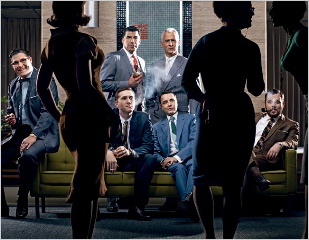
Or — HOW I WENT BACK TO THE ROOTS OF MY BEGINNINGS

The 70s. That’s when I started working as a designer. And a lot of the early work is about supporting other agencies. Ad agencies. When I began — when I first started working — my efforts were doing things like hand-drawing headlines for advertising agencies (called “comping”), drafting page layouts, building type fonts and alphabet systems, doing illustrations, customized logos, hand-drawn lettering and calligraphy, packaging and logos, special printed pieces, designs for lobbies, reception areas, museums and signing — trucks. That’s after being a signage designer, truck painter, storefronts and letterpress printer.
But it all fits together. You go from one thing to another — and if you recognize the thread, it all works; it weaves together. And you might go back to your roots — a recurrent theme for me in the late 90s.
Back then, leading a large design firm, working here, NYC, and other parts of the planet, I was no longer a designer: I was a CEO. And being a CEO really wasn’t for me. Being a creative leader is something closer to my heart — where I live. Living in, being in, the passion of creating content.
In the nature of being a designer, it’s wholly about creating content. Looking at the words, there’s more.
What I mean is that being a designer is about describing — description — that is: from the Latin (and the first usage 1340) — stem, describere, “to write down, to transcribe, copy, sketch. And that’s from script — first documented. 1374, “something written,” from Old French — escrit (Fr. écrit) “a writing, written paper,” and moving back in time — Latin scriptum “a writing, book, law, line, mark,” of scribere “to write,” from the ProtoIndoEuropean *skreibh- ( for reference –Greek skariphasthai “to scratch an outline, sketch,” Lett. skripat “scratch, write,” Old Norse hrifa “scratch“), from base *sker- “cut, incise” (cf. O.E. sceran “cut off, shear;” see shear) on the notion of carving marks in stone, wood, etc.
Working to find the heart of things, to get back to the truth of the craft of making.
Why do I keep doing that? Because that’s where the content lives — in the root of things, the root of your psyche, your presence. And your heart.
Which leads to ~
MAD MEN.
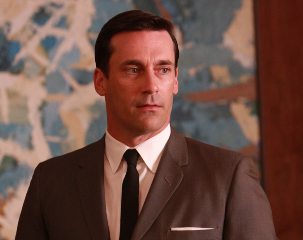
Jon Hamm as the quintessentially conflicted Don Draper
Seeing Mad Men, I can relate. Being a designer in the very beginning of my career, during the 70s, was about doing the root of the work — inked fingers, sliced with razors from cutting stencils, touched with the scent of photographic processing fluids, doing the ruling by hand, setting type, prepping the paper, folding stock with bone folders. And writing and organizing that content. And this was happening in the 70s — yes, it’s 10 years after the sequencing of Mad Men, but the sense was still there. Suits, ties, private offices, smoking and drinking, conflicts and challenges, affairs, drugs — all that. And it was there, then.
I worked for J.Walter Thompson, Leo Burnett, Klemtner, Grey, Ogilvy Mather, Young & Rubicam, Doyle, Dane Bernbach — and plenty of other big agencies. From the creative director down to the art buyers, I was there, pitching and plying the freelance designer’s trade.
Mad Men, in a way, reminds me of that time — and more recently, the return to that time. There was that separation — that earlier phase of living and working, being in the heart of the practice, building the expertise — and being disconnected, rolling in the work and the repetitive projects, and now, returning to that renewed focus and effort. Back again.
That’s what is driving the critical reviews of Mad Men — and its audience of 2 million viewers — it’s a delicate time for us all, and that TV series somehow revels in a better time — those roots, that nostalgia. (Greek — nostos “homecoming” + algos “pain, grief, distress“). We want to go back to another time — we need to get back to finding our selves again. Or try.

And Mad Men depicts the struggle of trying to do that — to return. Nearly every character is experiencing some attribute of the conflict and hopeful sense of rediscovery beneath the travails of the grind of the work.
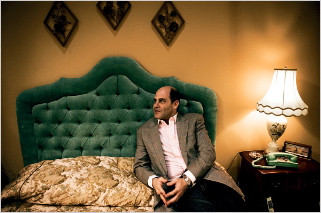
Matthew Weiner, originator of Mad Men
foto by Olaf Blecker, The New York Times
This inventive characterization rises from the mind of Matthew Weiner, creator,executive producer and head writer, on the set of “Mad Men.” He presented the program series concept first to HBO, where he worked as a writer on “The Sopranos.” The network passed, AMC picked it up, and the rest is cable history. And he’s been described as an extraordinary “art director”.
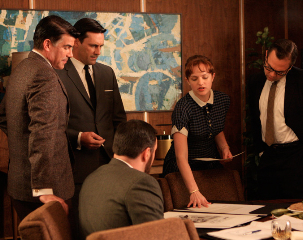
The original idea was his: he wrote the pilot; he writes all episodes of all programming (along with four other people); he’s the executive producer who bargains for budgeting ($2.3 million per episode); and he directs every actor, costume, hairstyling and set prop. He holds a stylistic “tone meeting” with the director. During this “presentation”, he essentially performs the entire show himself so it’s perfectly aligned in matching his vision.
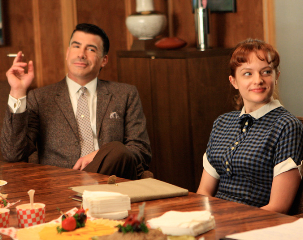
And the foundation, the scene from which he came — working for 18 years, most recently as a writer and executive producer for “The Sopranos” (the episode in which Tony murders his nephew Christopher was his), Weiner, 42 years old, is an overnight success in a very particular, Hollywood updraft.
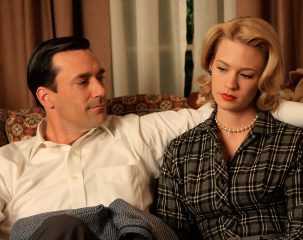
Alex Witchel notes: “He is both ultimate authority and divine messenger, some peculiar hybrid of God and Edith Head. “I do not feel any guilt about saying that the show comes from my mind and that I’m a control freak,” he told me. “I love to be surrounded by perfectionists, and part of the problem with perfectionism is that by nature, you’re always failing.” That of course, is an added detail for the concept of the story — even the ideator of the concept is struggling to find the right thing.
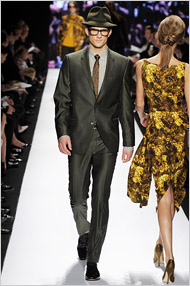
Michael Kors “Mad Men” design collection
The story spreads. People become entangled in the fantasy of what was then, and what is now. Including Michael Kors, the designer.
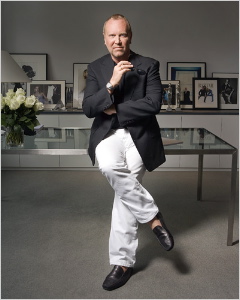
Brian Berman for The New York Times
Mr. Kors’s signature presence (aside from Project Runway, his television show) — as a designer, a stylist and a personality — derives partly from “the contradictory desires to escape that past and to embrace it”, according to The New York Times. And I might offer that his positioning, interestingly enough, is about the same thing that I’ve been referencing — finding roots. Exploring them, tuning them, returning to them. “His fashions display an infatuation with the traditionalism of the Eastern Seaboard haute bourgeoisie. Yet he also likes to tweak it for customers who want to look polished and prosperous but hip. In person Mr. Kors makes a near fetish of affecting a patrician ease, but he cannot resist the self-deprecating quip.
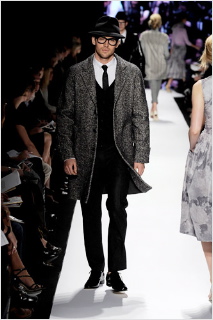
His intuition for catering to and captivating clients’ fantasies — and his mounting visibility in the markets and television — have combined to transform his once modest business into a powering up fashion brand with more than 60 stores and $600 million in wholesale sales revenues.
“Michael is firing on all cylinders,” said Terry J. Lundgren, the chief executive of Macy’s Inc., the parent company of Macy’s and Bloomingdale’s, where sales of the designer’s sportswear and accessories have surged. “This is his moment.” Mr. Kors, 49, a presence in American fashion for nearly three decades, views such pronouncements skeptically. “My moment? Well, I’ve had a few,” he said.
Speaking of moments, his link in finding his roots (30 years in the trade) Fashion Weekly retorts: Michael Kors, mad? Only for Mad Men. Last night, (July 28) the dapper designer (and television star) hosted an exclusive private screening for the season premiere of the hit AMC show’s second season at the Bryant Park Hotel. “How many times do you find something that’s smart, chic and entertaining all at once?” Kors asked, as waiters wandered about with trays of sixties-era appetizers like pigs in a blanket, mini meatloaf balls and petite quiches stuffed with–what else?–macaroni and cheese. “Strangely enough, the show is like a the zeitgeist. It’s the year of Mad Men and Amy Winehouse. But she’s doing her own thing with 1961.” The year of Kors’ birth, no less!”
AdAge notes, “Mad Men” has conjured up nostalgia, hostility and more than a few Emmy nominations. And now the slick world of Sterling Cooper is inspiring fashionistas everywhere.
From Madison Ave to Fifth Ave: Many designers have cited the show as an influence and retailers are stocking their shelves accordingly. This past month, John Slattery (Roger Sterling) is featured in a six-page fashion spread in GQ.
The 1960s-era AMC series is causing a stir in the fashion world this fall, with designers citing it as their muse and retailers stocking their shelves accordingly. Thanks to Don Draper, Joan Holloway and the gang, slim suits, skinny ties, sheath dresses and pearls are finding their way into the closets of consumers. “As far as TV shows go, [“Mad Men”] probably has the most influence [on fashion],” said Kevin Harter, VP-fashion direction at Bloomingdale’s. “And we’re going to see this influence continue.” Bloomingdale’s is doing plenty to expose the show in the context of window marketing, they’ve featured “Mad Men” in store windows and launched shops-in-shops that stock clothing, accessories and barware in keeping with the show’s sensibility. The shops have been so successful, said Mr. Harter, that they will stay open through the fall season. An event with cast members at the end of September will be the culmination of the campaign.
The timing of the series, it seems, was a perfect synchrony, offering a refreshing alternative to the flip-flops, flounces and baby-doll dresses that had become de rigueur — Sex in the City — Housewives in Desperation… Michael Kors, who has declared the show as an influence for his fall collection, was tired of casual, dressed-down looks, said Billy Daley, VP-communications for the label. “[Michael] wanted to return to a polished, more dressed, more grown-up look,” he said. “And he realized he was obsessed with ‘Mad Men.'”
Mr. Kors began watching the show last summer and eventually met creator and executive producer Matthew Weiner. The meeting led to a private screening of the season premiere for friends and fans of Michael Kors, as well as a newly launched gift-with-purchase promotion. “It’s been an amazing thing to be inspiring so many fashion designers,” said Katherine Jane Bryant, the costume designer for “Mad Men.” “I was really surprised. … But it’s been a long time coming. American fashion has been so comfortable for so long.”
The show’s influence and audience are growing quickly — the series premiere pulled in nearly 2 million viewers — and will only gain steam throughout the fall. Mr. Harter predicted that the cast will be regulars on the fashion circuit before long, noting that GQ features John Slattery, who plays Roger Sterling, in a six-page fashion spread in its August issue.
“Take a power magazine like GQ, and they’re basically endorsing the show and certainly the style of the show. [GQ] has a lot of influence over the way men dress,” Mr. Harter said.
AMC is fully embracing its newly minted fashion status. On July 30, the network launched a blog called Fashion File, which is authored by Faran Krentcil, founder of the website Fashionista. And although Target is the only official fashion or retail sponsor of the show, it’s likely only a matter of time before new partnerships emerge. Linda Schupack, senior VP-marketing at AMC, said the Bloomingdale’s partnership shows that the series can successfully live “off air.”
“We’re so pleased to get the fashion coverage because it’s just another way into ‘Mad Men.’ And it’s an important way in,” Ms. Schupack said. “It’s just a furthering of ‘Mad Men’ being a part of the pop-culture conversation.”
I’m thinking about going back to the roots, creatively. Stylistically too. Nice suit, this suite.
Given all that, what’s the take from the advertising community? Not much, given the rather cold-hearted portrayal(s). AdAge comments: “Since the first episode of AMC’s “Mad Men” drama aired last Thursday, the Manhattan advertising community has been abuzz over the program’s unvarnished view of the ad business as it existed in 1960. Critically acclaimed but more than a little controversial, the show has been characterized by various publications as cynical, racist, misogynistic, anti-Semitic and drenched in sex. Ad Age television editor Brian Steinberg discusses the reactions that have ranged from cold shock to nostalgic yearning.” Check out this “designer’s interpretation” of the world of Sterling Cooper 1960’s design for the entire issue: http://adage.com/article/special-report-mad-men/mad-men-fashion-muse/130074/
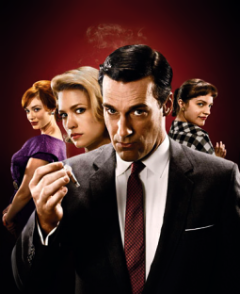
What’s your take? What root will you reach back to? And what’s your story, anyway?
tsg | seattle
Sources: AdAge, AMC blogs and MadMen site, GQ, FashionWeekly, WWD, Kors.com, MenStyle.com